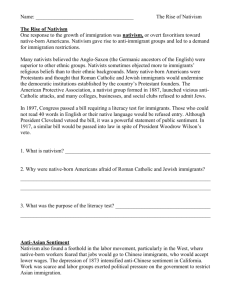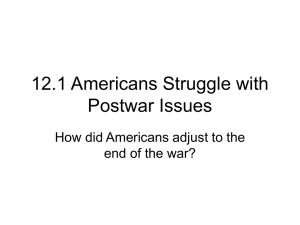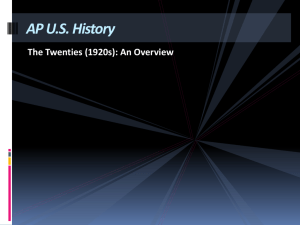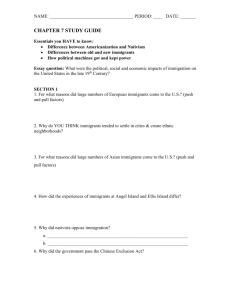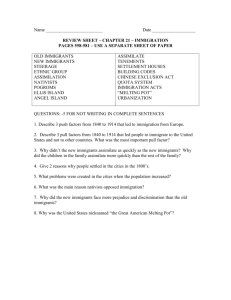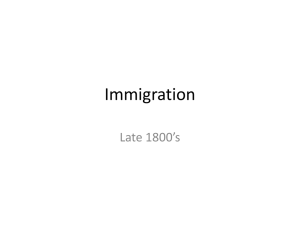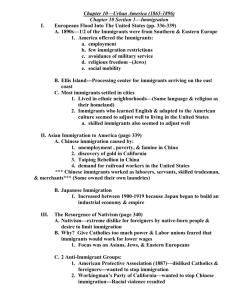Nativism
advertisement
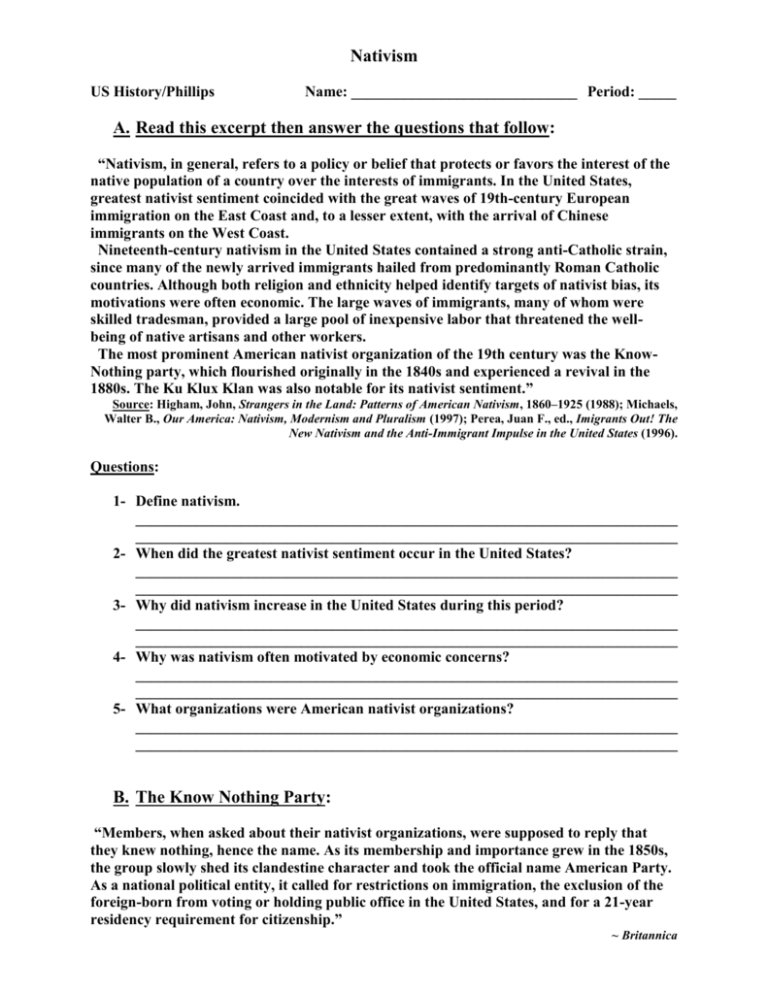
Nativism US History/Phillips Name: ______________________________ Period: _____ A. Read this excerpt then answer the questions that follow: “Nativism, in general, refers to a policy or belief that protects or favors the interest of the native population of a country over the interests of immigrants. In the United States, greatest nativist sentiment coincided with the great waves of 19th-century European immigration on the East Coast and, to a lesser extent, with the arrival of Chinese immigrants on the West Coast. Nineteenth-century nativism in the United States contained a strong anti-Catholic strain, since many of the newly arrived immigrants hailed from predominantly Roman Catholic countries. Although both religion and ethnicity helped identify targets of nativist bias, its motivations were often economic. The large waves of immigrants, many of whom were skilled tradesman, provided a large pool of inexpensive labor that threatened the wellbeing of native artisans and other workers. The most prominent American nativist organization of the 19th century was the KnowNothing party, which flourished originally in the 1840s and experienced a revival in the 1880s. The Ku Klux Klan was also notable for its nativist sentiment.” Source: Higham, John, Strangers in the Land: Patterns of American Nativism, 1860–1925 (1988); Michaels, Walter B., Our America: Nativism, Modernism and Pluralism (1997); Perea, Juan F., ed., Imigrants Out! The New Nativism and the Anti-Immigrant Impulse in the United States (1996). Questions: 1- Define nativism. ________________________________________________________________________ ________________________________________________________________________ 2- When did the greatest nativist sentiment occur in the United States? ________________________________________________________________________ ________________________________________________________________________ 3- Why did nativism increase in the United States during this period? ________________________________________________________________________ ________________________________________________________________________ 4- Why was nativism often motivated by economic concerns? ________________________________________________________________________ ________________________________________________________________________ 5- What organizations were American nativist organizations? ________________________________________________________________________ ________________________________________________________________________ B. The Know Nothing Party: “Members, when asked about their nativist organizations, were supposed to reply that they knew nothing, hence the name. As its membership and importance grew in the 1850s, the group slowly shed its clandestine character and took the official name American Party. As a national political entity, it called for restrictions on immigration, the exclusion of the foreign-born from voting or holding public office in the United States, and for a 21-year residency requirement for citizenship.” ~ Britannica The Know Nothing or American Party formed in 1853 and soon became the second largest political party in the United States behind the Democratic Party. By 1857, the party was dead. It was a victim of the growing controversy over slavery. A nativist group, the Know Nothings emerged in response to the influx of millions of Catholics from Ireland and Germany in the 1840s and 1850s. Nativism and antiCatholicism had long been traditions in American politics, but the waves of immigrants reignited these sentiments. Prejudice against Catholics among middle-class and workingclass Protestants was legitimized by the Protestant intelligentsia. Anti-Catholicism then became associated with the reform program of Protestant social activists campaigning for the abolition of slavery and the prohibition of liquor. Fear and hatred of Catholics created a need for secrecy among the nativists. When asked about their organization, they were instructed to say, “I know nothing.” Using the name American Party, the Know Nothings swept to political victory in Massachusetts, Delaware, Pennsylvania, Connecticut, Rhode Island, New Hampshire, Maryland, and Kentucky. American party tickets also ran strong races in Virginia, Tennessee, Georgia, Alabama, Mississippi, Louisiana, and Texas. By 1855, nativism seemed on the verge of carrying the entire country. In that year, Joshua F. Speed (1814–1882) of Kentucky, a longtime close friend of Abraham Lincoln, asked the future president about his views on the Know Nothings. Speed, the brother of Lincoln’s future attorney general James Speed, was a farmer and one-time state legislator who publicly supported slavery but who came from a family long opposed to it. During the Civil War, he would remain loyal to the Union and helped coordinate Union activities in Kentucky. State several facts about the Know Nothing Party: ______________________________________________________________________________ ______________________________________________________________________________ ______________________________________________________________________________ ______________________________________________________________________________ ______________________________________________________________________________ C. Answer the questions: Which expression most accurately illustrates the concept of nativism? (1) “Help Wanted – Irish Need Not Apply” (2) “Go West, young man.” (3) “America – first in war and peace” (4) “The only thing we have to fear, is fear itself.” The Gentlemen’s Agreement, literacy tests, and the quota system were all attempts by Congress to restrict: (1) (2) (3) (4) immigration property ownership voting rights access to public education Speaker A: “Our nation has grown and prospered from the ideas and labor of immigrants. The nation has been enriched by immigrants from different nations who brought new ideas and lifestyles, which have become part of American culture.” Speaker B: “United States industries are competing with established European manufacturers. To prosper, American industries need the vast supply of unskilled labor that is provided by immigrants.” Speaker C: “Immigrants are taking jobs at low wages without regard for long hours and workers’ safety. American workers must unite to end this unfair competition.” Speaker D: “Immigrants arrive in American cities poor and frightened. They are helped to find jobs or housing. These newcomers should show their gratitude at voting time.” Which speaker is most clearly expressing the melting pot theory? (1) A (2) B (3) C (4) D The data in the chart support the idea that the immigration laws of 1921 and 1924 were primarily designed to (1) stop illegal entry into the country (2) admit skilled workers (3) encourage immigration from southern Europe (4) reduce immigration from specific regions Between 1880 and 1920, the majority of the “new” immigrants to the United States came from (1) northern and western Europe (2) southern and eastern Europe (3) Canada and Latin America (4) China and Southeast Asia Between 1890 and 1915, the majority of immigrants to the United States were labeled “new immigrants” because they were (1) considered physically and mentally Speaker D is expressing an opinion most like superior to earlier immigrants that of a (2) forced to settle in the cities of the (1) labor union member Midwest (2) religious leader (3) from China, Japan, and other Asian (3) factory owner countries (4) political party boss (4) culturally different from most earlier immigrants D. Analyze the following chart and answer the questions that follow: Cultural Pluralism Versus the Melting Pot: a) The “melting pot” is the concept that suggests that all immigrants absorb the aspects of a uniform American culture, and as a result, become “Americanized.” b) Yet although different ethnic groups become Americanized, they also maintain a degree of their cultural heritage. This idea of “cultural pluralism,” rather than a pure melting pot, was first expressed in 1915 by Horace Kallen. ~ U.S. History and Government Nativism: Immigration Restrictions: a) Native-born Americans have demonstrated “nativism” toward immigrants of minority groups who have deviated from the dominant culture. a) On a number of occasions, Congress has responded to nativist sentiments with the passage of restrictive legislation. b) Nativists groups discriminated against individuals because of race, religion, political beliefs, and economic fears. c) The Ku Klux Klan originated as primarily an anti-black organization during the Civil War era and resurfaced as an antiSemitic, anti-Catholic, and anti-immigrant group in the 20th century 1- The Chinese Exclusion Act (1882) – restricted Chinese immigration for a 10-year period 2- Gentleman’s Agreement (1907) – Japan persuaded to deny passports to those who wanted to emigrate 3- Literacy Test (1917) – Immigrant required to pass literacy test in either English or another language 4- Immigration Act of 1921 – Quota system set at 3% of total of that nationality in U.S. in 1910; general limit of 350,000 immigrants per year Questions: 1- Explain the concept of the “melting pot.” ________________________________________________________________________ ________________________________________________________________________ 2- Define “cultural pluralism”. ________________________________________________________________________ ________________________________________________________________________ 3- Why does the concept of “cultural pluralism” accurately reflect the descendants of many immigrants? ________________________________________________________________________ ________________________________________________________________________ 4- Define nativism. ________________________________________________________________________ ________________________________________________________________________ 5- What “fears” increased nativism’s popularity? ________________________________________________________________________ ________________________________________________________________________ 6- What is the Ku Klux Klan and what are its goals? ________________________________________________________________________ ________________________________________________________________________ 7- How did representatives in Congress sometimes respond to nativist concerns? ________________________________________________________________________ ________________________________________________________________________ 8- What was the Chinese Exclusion Act? ________________________________________________________________________ ________________________________________________________________________ 9- What was the Gentleman’s Agreement? ________________________________________________________________________ ________________________________________________________________________ 10- What was the Literacy Test? ________________________________________________________________________ ________________________________________________________________________ E. Read the excerpt and answer the questions that follow: “In the mid-1840’s, following defeat by Britain in the first Opium War, a series of natural catastrophes occurred across China resulting in famine, peasant uprisings and rebellions. Understandably, when the news of gold and opportunity in far away Gum San, (Golden Mountain – the Chinese name for America) reached China, many Chinese seized the opportunity to seek their fortune. The Chinese were met with ambiguous feelings by Californians. In 1850, San Francisco Mayor John W. Geary invited the ‘China Boys’ to a ceremony to acknowledge their work ethic. However, as the American economy weakened, the Chinese labor force became a threat to mainstream society. Racial discrimination and repressive legislation drove the Chinese from the gold mines to the sanctuary of the neighborhood that became known as Chinatown. The only ethnic group in the history of the United States to have been specifically denied entrance into the country, the Chinese were prohibited by law to testify in court, to own property, to vote, to have families join them, to marry non-Chinese, and to work in institutional agencies.” ~ pbs.org Identify reasons why the Chinese came to the United States: ______________________________________________________________________________ ______________________________________________________________________________ ______________________________________________________________________________ Identify the ways in which Chinese immigrants faced discrimination in the United States: ______________________________________________________________________________ ______________________________________________________________________________ ______________________________________________________________________________

